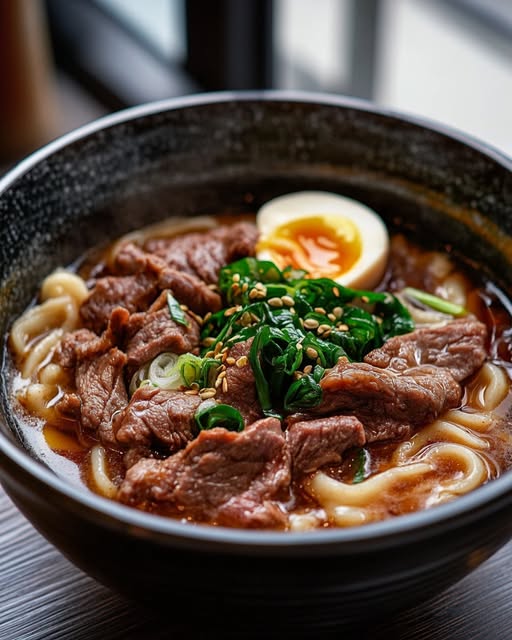Discover the Magic of Beef Udon Delight
Picture this: a steaming bowl of chewy udon noodles swimming in a rich, savory broth, topped with tender beef slices that melt in your mouth. Sounds like a dream, right? That’s exactly what happened when I first tried Beef Udon Delight. It was love at first slurp. This dish is more than just comfort food—it’s a hug in a bowl. Whether you’re cooking for family or friends, this recipe will have everyone asking for seconds.
The Story Behind Beef Udon Delight
Udon noodles have been a staple in Japanese cuisine for centuries. These thick, chewy noodles are often served in a simple dashi broth, but when paired with marinated beef, they transform into something extraordinary. The dish we’re making today is inspired by Marc Matsumoto’s recipe, which balances umami-rich flavors with minimal effort. When I first made it, I was amazed at how easy it was to recreate restaurant-quality udon at home. Plus, adding beef gives it a hearty twist that makes it perfect for colder nights or cozy dinners.
Why You’ll Love This Recipe
This Beef Udon Delight is a winner for so many reasons. First, the flavor profile is unbeatable—savory, slightly sweet, and deeply satisfying. Second, it’s incredibly versatile. You can tweak it to suit your taste or dietary needs without losing its essence. Lastly, it’s quick! With just 37 minutes from start to finish, you can whip up a restaurant-worthy meal on even the busiest weeknights. Trust me; once you try this, it’ll become a regular in your dinner rotation.
Perfect Occasions to Prepare This Dish
Whether you’re hosting a casual dinner party or need a comforting meal after a long day, this dish fits the bill. It’s also fantastic for chilly evenings when you want something warm and filling. I’ve served it during game nights, family gatherings, and even as a surprise treat for my best friend’s birthday. Everyone loves how flavorful yet comforting it feels.
Ingredients for Beef Udon Delight
- For the Soup:
- 625 ml of dashi broth
- 2 tablespoons soy sauce
- 1/4 teaspoon salt (optional)
- 2 servings of udon noodles
- Shichimi togarashi (optional, for garnish)
- For the Beef:
- 125 ml dashi broth
- 2 tablespoons sake
- 2 tablespoons soy sauce
- 1 tablespoon evaporated cane sugar
- 225 g thinly sliced beef
- 60 g scallions (white and green parts separated)
Substitution Options
If you can’t find dashi broth, substitute it with vegetable or chicken stock infused with a bit of kombu seaweed. For a gluten-free version, use tamari instead of soy sauce. If you’re not a fan of beef, swap it out for thinly sliced pork or chicken. Scallions can be replaced with chives if needed.
Preparation Steps
Step 1: Prepare the Soup Base
Start by heating your dashi broth and soy sauce in a pot over medium heat. Bring it to a gentle boil, then reduce the heat to low. Taste the broth—if it needs a pinch of salt, go ahead and add it. Keep this soup warm while you prep the rest of the ingredients. Pro tip: Letting the flavors meld together makes all the difference!
Step 2: Marinate and Cook the Beef
In a separate pan, combine another portion of dashi, sake, soy sauce, sugar, and the white parts of the scallions. Bring it to a boil, then carefully add the beef slices. Stir gently to separate them and let them simmer until tender. The aroma of soy and sake mingling is pure magic. Once the beef is cooked, stir in the green parts of the scallions for freshness.
Step 3: Cook the Udon Noodles
Boil water in a large pot and cook the udon according to package instructions. These noodles are thicker than spaghetti, so they hold up beautifully in soups. Drain them well before adding them to your bowls. Chef’s tip: Undercook the noodles slightly if you prefer them firmer.
Step 4: Assemble Your Bowls
Divide the hot broth between two bowls. Add the drained udon noodles, followed by the beef slices and their flavorful sauce. Sprinkle some shichimi togarashi on top for a spicy kick. Voila! Your Beef Udon Delight is ready to serve.
Timing Breakdown
- Preparation Time: 20 minutes
- Cooking Time: 17 minutes
- Total Time: 37 minutes
Chef’s Secret
To elevate the flavor, toast the scallion whites briefly in the pan before adding liquids. This brings out their natural sweetness and adds depth to the dish.
Extra Info
Dashi broth is traditionally made using dried bonito flakes and kombu seaweed. However, instant dashi granules are widely available and make life easier. They’re a pantry staple I highly recommend keeping on hand.
Necessary Equipment
- A medium-sized pot for the soup
- A frying pan for the beef
- A large pot for boiling noodles
- A ladle and serving bowls
Storage Tips
You can store leftover broth and beef separately in airtight containers in the fridge for up to three days. Reheat gently on the stove before serving. Avoid freezing the noodles, as they lose texture upon thawing. For best results, keep everything chilled but assemble fresh when reheating.
If you plan to freeze the beef mixture, do so without the scallion greens—they don’t hold up well in the freezer. Thaw overnight in the fridge before reheating.
Always cool down leftovers completely before refrigerating to prevent spoilage. Use shallow containers for faster cooling.
Tips and Advice
Don’t rush the beef cooking process; slow simmering ensures tenderness. Use high-quality dashi for the best flavor. And remember, presentation matters—even a sprinkle of green onions can make your dish pop!
Presentation Ideas
- Garnish with extra scallions for color.
- Add a soft-boiled egg for richness.
- Serve with pickled ginger on the side.
- Use decorative bowls to enhance visual appeal.
Healthier Alternatives
Here are six ways to lighten up your Beef Udon Delight:
- Low-Sodium Option: Use low-sodium soy sauce and reduce added salt.
- Vegan Version: Replace beef with tofu or mushrooms.
- Whole Grain Twist: Swap udon for whole wheat soba noodles.
- Less Sugar: Cut the sugar in half or omit it entirely.
- More Veggies: Add spinach or bok choy to the broth.
- Light Broth: Dilute the dashi with water for a milder taste.
Common Mistakes to Avoid
Mistake 1: Overcooking the Noodles
Overcooked udon becomes mushy and loses its delightful chewiness. Follow package instructions carefully and test for doneness frequently. Pro tip: Al dente noodles absorb flavors better.
Mistake 2: Skipping the Simmering Step
Rushing the beef cooking step can result in tough meat. Patience pays off here; let it simmer slowly to achieve melt-in-your-mouth tenderness.
Mistake 3: Using Stale Dashi
Fresh dashi makes a world of difference. If using instant granules, ensure they’re within their expiration date for optimal flavor.
FAQ
What is dashi?
Dashi is a Japanese stock made from dried bonito flakes and kombu seaweed. It forms the base of many Japanese dishes, including soups and sauces.
Can I use store-bought dashi?
Absolutely! Instant dashi granules are convenient and work perfectly fine for this recipe.
Is sake necessary?
Sake adds depth to the dish, but you can skip it if unavailable. Substitute with a splash of rice vinegar for acidity.
Where can I buy udon noodles?
Check Asian grocery stores or online retailers. Many supermarkets now carry them in the international aisle.
How do I know when the beef is done?
The beef should be tender and no longer pink. Most importantly, there should be very little liquid left in the pan.
Can I make this dish vegetarian?
Yes! Replace beef with tofu or tempeh and use vegetable broth instead of dashi.
What is shichimi togarashi?
It’s a Japanese spice blend containing chili pepper, sesame seeds, and other seasonings. It adds heat and complexity to dishes.
Can I double the recipe?
Of course! Simply adjust ingredient quantities accordingly and use larger pots and pans.
How do I reheat leftovers?
Reheat broth and beef separately on the stove. Cook fresh noodles and assemble the dish just before serving.
What sides pair well with this dish?
Tempura, gyoza, or a simple cucumber salad complement this dish beautifully.
Final Thoughts
There’s nothing quite like the joy of creating a delicious meal that brings people together. Beef Udon Delight does exactly that—it’s hearty, flavorful, and oh-so-satisfying. Whether you’re new to Japanese cuisine or a seasoned pro, this recipe promises to delight your taste buds and warm your soul. So grab your apron and get cooking—you’ve got this!

Beef Udon Delight
Ingredients
Equipment
Method
- Heat dashi broth and soy sauce in a pot over medium heat, bring to a gentle boil, then reduce heat to low and season with salt as needed.
- In a separate pan, combine dashi, sake, soy sauce, sugar, and the white parts of scallions. Bring to a boil and add beef slices, simmer until tender.
- Boil water in a large pot and cook udon noodles according to package instructions, then drain.
- Divide hot broth between two bowls, add udon noodles, top with beef and sauce, and garnish with shichimi togarashi.
